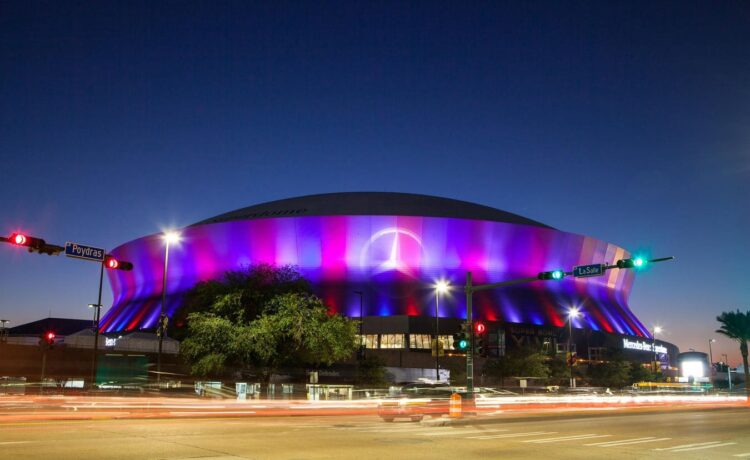New Orleans, USA – January 23rd 2013: New Orleans Superdome lit up at night just days before the … [+]
Half of all advertising dollars may go to waste, but surely that half is spent on something other than the Super Bowl.
This year, total Super Bowl ad spend could surpass the billion-dollar mark for the first time, with nearly an hour of commercial slots sold at an eye-popping rate of around $8 million each; up from $2.2 million two decades ago.
Ads have become central to the Super Bowl experience to the point where one-third of viewers tune in primarily to watch the commercials.
Super Bowl ads often generate buzz long after the final whistle both home and abroad, which is why it’s no surprise that CEOs are willing to pay millions for a 30-second moment in the spotlight.
But what exactly is the return they’re after, and how can they ensure they get it?
A global stage and a brand to build
In just a few hours, hundreds of millions of viewers will see Papaya Global, a payments facilitation company, step boldly into that stage.
They’re unveiling a high-energy spot where the main character experiences a “workmare” of taxes, regulations, and exchange rates, an endless whack-a-mole scenario, until he’s reminded that Papaya Global handles those complex workforce payments for him.
It’s a classic Super Bowl ad formula: entertainment and energy followed by a punchy reveal of the problem Papaya Global solves.
For Papaya Global’s CEO, Eynat Guez, staking a claim on this pricey advertising real estate is a carefully calculated move aimed to capture customers and position the brand as the go-to solution for global workforce payments.
“This campaign is about making workforce payments a category in its own right,” Eynat begins.
“A payments-first approach is solving one of the most overlooked challenges in global business, ensuring every worker, everywhere, gets paid accurately, compliantly, and on time, and this ad tells that story to the audience we want to reach”, she adds.
A Super Bowl commercial is perhaps the most high-profile way to tackle a universal problem for companies: customer acquisition.
The steep price for a 30-second spot forces teams to stay razor-focused on messaging and creativity. Almost paradoxically, these constraints are also what spark innovation, as was evident in Kanye West’s DIY “gonzo” ad last year that had no production budget and still pulled in $19.3 million in sales within 24 hours.
West’s returns are by no means an outlier mind you. In fact, Kantar has estimated that the average Super Bowl ad is 20 times more effective than your run-of-the-mill ad.
At Papaya Global, the high-stakes environment prompted a keen focus on engagement.
“We’re making CFOs laugh while also educating them, a rare feat in B2B marketing. And we’re doing it on the biggest stage in advertising, ensuring workforce payments finally get the spotlight they deserve,” says Zvika Liblich, Chief Strategy Officer at Papaya Global.
The reason why many other companies are following suit is that although awareness is crucial, it is only the first step. Brands still need to persuade viewers to move closer to a purchase.
Modern audiences want their companies to go beyond flashy ads; they want a brand that they can connect with and trust. Accomplishing all that in a 30 second slot is quite a feat.
“This isn’t just a branding play, it’s a category-defining moment,” Zvika added, explaining how Papaya Global uses their time in the limelight to push for category ownership with an ad that entertains and a brand that resonates.
Experts in the field echo the need for taking a bold approach to the 30 seconds at play here.
“Super Bowl ads are a great antidote to the mediocrity that is a result of the endless grind of ad optimization,” says Theodor Arhio, a brand strategist who has worked with Expedia, Apple, McDonald’s, and Omnicom.
“The take away from Super Bowl’s attention-grabbing marketing is to apply the same creativity and bravery to your daily grind. Out-entertain your boring competition whether it’s at the Super Bowl or your next ad on a podcast no one knows, that’s how you build a brand that moves audiences towards you and from the competition,” Theodor adds.
What it takes to pull a Super Bowl ad together
What we see on Super Bowl Sunday is often just the tip of the iceberg.
Many brands spend the better part of a year preparing, iterating, and refining every detail of their ad, and some don’t even stop once the game ends.
Papaya Global’s 30-second spot is part of a broader campaign designed to maximize a multimillion-dollar investment through TV, digital, and social channels.
Multimodality and omnichannel tactics play a crucial role in keeping audiences engaged before, during, and after the big game.
Knowing what you want from every second on air is essential when the stakes are this high.
“Setting KPIs from the outset is the only way to measure whether your story truly resonates,” says Theodor Arhio.
“Without clear targets, you’re just throwing money at airtime and hoping something sticks,” he adds.
Papaya Global identified its objectives well before production began. “Our KPIs include surpassing 50 million impressions, boosting website traffic by 200%, and driving the kind of brand lift that positions us as synonymous with workforce payments,” Zvika explains.
Establishing metrics early helps ensure that each creative choice aligns with the ultimate goal. This process also hinges on iteration and testing to make sure what you are creating is ready for the right landing.
Papaya Global landed on their collaboration with McCann Tech and director Bruce St. Clair after a lengthy conceptualization and testing period, which ultimately led to the ‘workmare’ ad filmed in Cape Town, South Africa by Director Bruce St. Clair and Creative Director Alon Seifert.
Whether Papaya Global ends up defining the category as they hoped for is for the viewers to decide.
But for Zvika, the journey here has already been its own rewards
“The most rewarding part of this process is seeing a complex B2B problem transformed into something universally relatable,” she concludes, exemplifying how storytelling, even through ads, is often a joy to take part in.
Maybe the ROI is the lessons we learnt along the way
Papaya Global’s ad is just one among many, but the lessons we can derive from examining its anatomy are universal.
One recurring lesson is that big bets demand thorough planning, brands sometimes start more than a year in advance, layering strategic targets with detailed creative experiments.
Another lesson reinforces the power of the right talent. From the creative leads to the director on set, every contributor shapes the final narrative, underscoring how details can make or break the viewer’s connection.
A third takeaway emphasizes clarity over complexity.
In a world flooded with content, a single, memorable idea often carries more weight than a sprawling attempt to showcase everything a company does.
These principles aren’t confined to the Super Bowl.
Any brand looking to capture attention, whether in front of millions of sports fans or a niche podcast audience, can benefit from the same discipline.
















